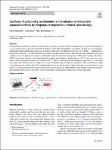Search
Author
- Felix, Leibetseder (1)
- Francesca, Luziatelli (1)
- Julia, Bičvić (1)
- Klaus, Bretterbauer (1)
- next >
Subject
Date issued
- 2023 (2)
Has File(s)
- true (2)
Search Results
Differential scanning calorimetry (DSC) was used as an efficient and rapid tool in studying the conformational transitions between the folded and unfolded structures of cellulolytic enzymes. The thermal properties of two crude hydrolytic enzyme cocktails containing extracellular cellulases from Trichoderma longibrachiatum DIBAF-10 were analyzed and compared with three commercial cellulase preparations. Differences in the thermal behavior of fungal cellulases in the liquid phase, freeze-dried state, liquid formulations in sodium citrate buffer (pH 4.8), and contact with cellulose, carboxymethyl cellulose, and cellobiose were evaluated. DSC profiles of cellulases from the DIBAF-10 strain provided important thermodynamic information about the thermal stability of the included proteins.... |
Common linear polymers are known to undergo phase changes at the glass-transition temperature (Tg) and the melting point (Tm). In recent years, it has also been shown that molecules with long aliphatic side chains can give rise to a backbone-independent melting phenomenon, known as nanophase separation. This effect describes the self-assembly — independent of the polymer backbone — of alkyl side chains into semi-crystalline nanostructures. This work presents optimized, gram scale synthesis routes for dodecyl and octadecyl acrylamide and their respective homopolymers. Differential scanning calorimetry (DSC) experiments detected a broad endothermal signal for poly(n-dodecyl acrylamide) at − 29 °C and a narrower, more intense signal for poly(n-octadecyl acrylamide) at 34 °C. These sign... |


